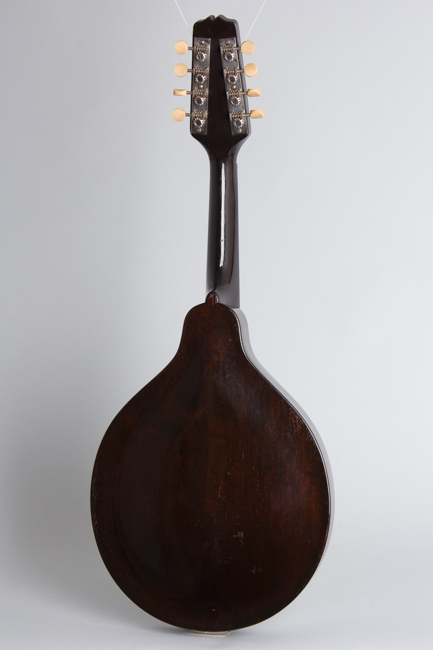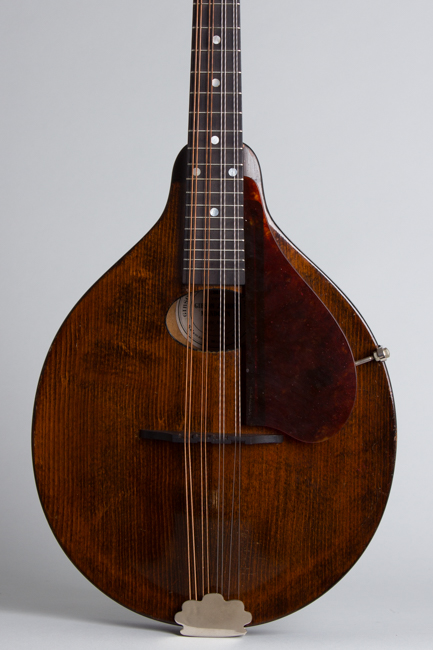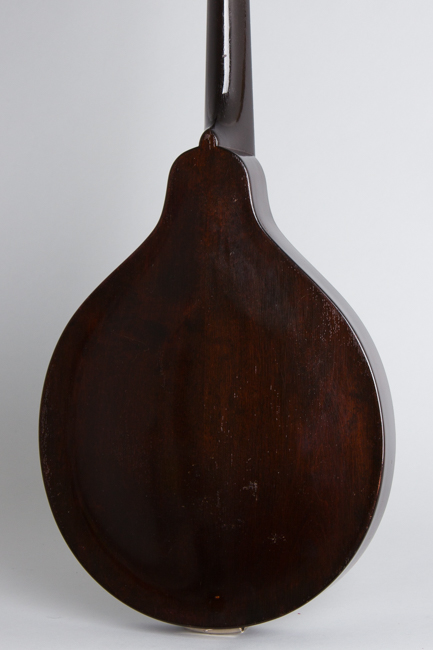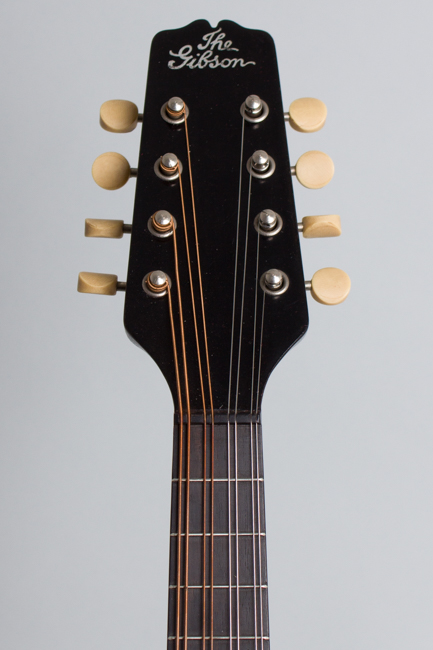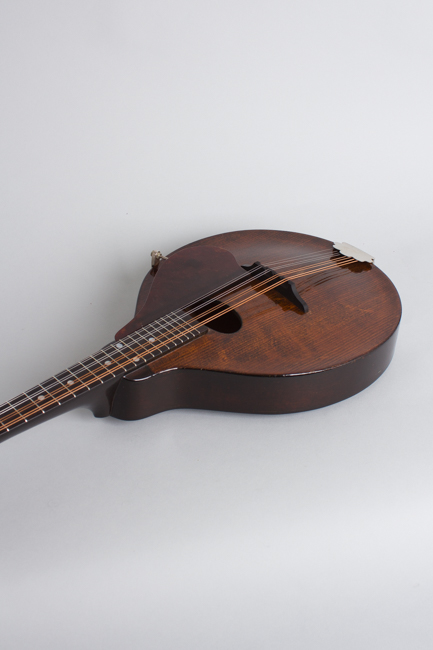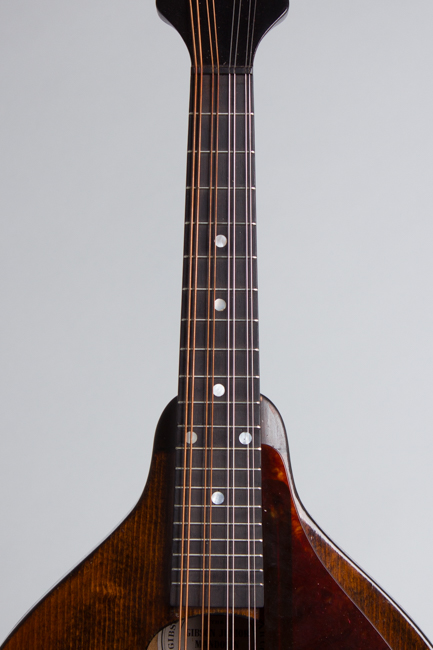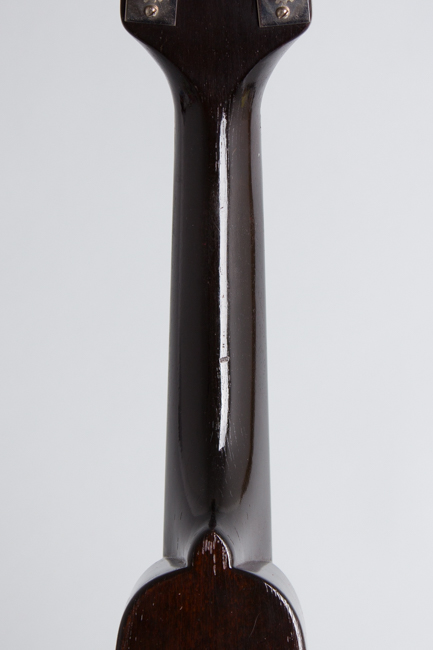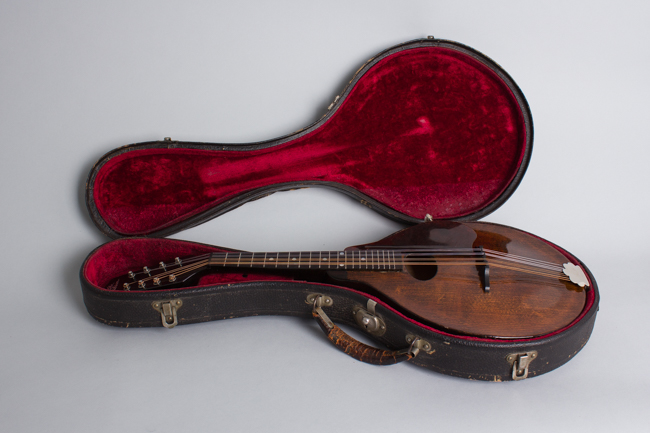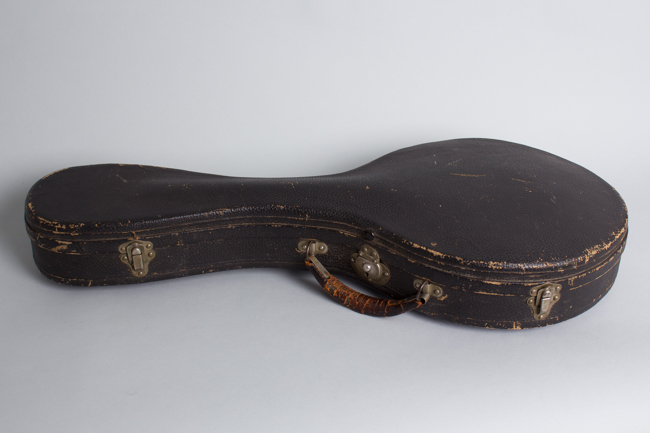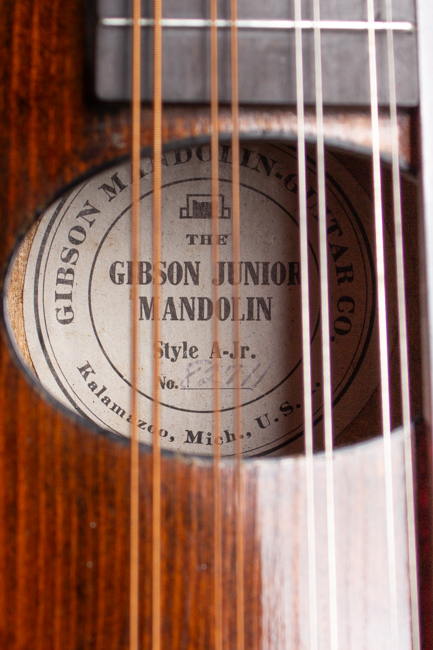Gibson A-Junior Snakehead Carved Top Mandolin (1927)
Summer Sale - PRICE REDUCED!
$2,500.00 + shipping
Buy NowItem # 11239
Prices subject to change without notice.
Gibson A-Junior Snakehead Model Carved Top Mandolin (1927), made in Kalamazoo, Michigan, serial # 82711, brown stain finish, birch back and sides, spruce top; mahogany neck with ebony fingrboard, original black hard shell case.
This is a great-playing and sounding original A-Junior mandolin from late 1927/early 1928, some time after the "Loar era" at Gibson, but still embodying many of "Master Loar's" ideas. This is a lovely example of Gibson's mandolin craftsmanship, even though by the time it was built the company's focus had shifted primarily to banjos. "Snakeheads" are generally considered the best-sounding roundhole "A" style mandolins ever made, revered for their unmatched tone and projection compared to earlier or later A-models. Although the A-Junior was the lowest priced model offered this one certainly bears this out.
"Snakehead" instruments are named for their Loar-designed peghead that angles inward towards the tip, a feature inexplicably abandoned by Gibson not long after this one was made. While this basic A-Junior lacks some of the other advanced features of the era (it does not have an adjustable truss rod or height-adjustable bridge) it does sport Loar's slimmer neck profile and sleeker peghead shape. The finish is a clear lacquer coat over an overall brown stain; this is the period when Gibson was switching from varnish to lacquer finishes and the results were sometimes inconsistent. This one is shinier than some but appears all original. The FON (factory order number) on the neck block indicates it was made in later 1927, the penciled serial number on the special "Junior" label suggests it was shipped out in early 1928.
There is no binding at all, but the same tortoise celluloid pickguard as the higher grade models is secured by the later '20s side bracket clamp. The tailpiece has a simple "clamshell" cover plate and the tuners are plain openback strips. Even this most basic "A" model is a very fine instrument, with sonic and playing improvements carrying over from "Master Loar's" tenure still evident in the later 1920s, and nearly 100 years on making for a very fine (if plain looking) mandolin.
Overall length is 25 3/4 in. (65.4 cm.), 10 1/4 in. (26 cm.) wide, and 1 7/8 in. (4.8 cm.) in depth, measured at side of rim. Scale length is 14 in. (356 mm.). Width of nut is 1 3/16 in. (30 mm.).
This near century-old old mandolin appears to have seen comparatively little use since new, remaining an excellent player with a lively sound. The original lacquer finish has a lovely aged patina, still shiny with just typical fairly minor checking and some small dings, dents, and scrapes overall. The top in particular remains quite clean and completely free of the typical pick wear. There are no visible crack or other repairs, even all the back/side seams appear to be perfectly aligned and solid..
All hardware remains original and complete including the tuners, tailpiece and pickguard. The original carved ebony bridge appears to have been neatly lowered a bit from the top. The neck has remained true for 95 years and the original frets are very clean, probably polished out a bitt but showing hardly any wear. This an excellent example of Gibson's plainest 1920s A Model, much cleaner than most and complete in its original red-lined hard shell case that shows some external wear but is still fully solid. Excellent Condition.
This is a great-playing and sounding original A-Junior mandolin from late 1927/early 1928, some time after the "Loar era" at Gibson, but still embodying many of "Master Loar's" ideas. This is a lovely example of Gibson's mandolin craftsmanship, even though by the time it was built the company's focus had shifted primarily to banjos. "Snakeheads" are generally considered the best-sounding roundhole "A" style mandolins ever made, revered for their unmatched tone and projection compared to earlier or later A-models. Although the A-Junior was the lowest priced model offered this one certainly bears this out.
"Snakehead" instruments are named for their Loar-designed peghead that angles inward towards the tip, a feature inexplicably abandoned by Gibson not long after this one was made. While this basic A-Junior lacks some of the other advanced features of the era (it does not have an adjustable truss rod or height-adjustable bridge) it does sport Loar's slimmer neck profile and sleeker peghead shape. The finish is a clear lacquer coat over an overall brown stain; this is the period when Gibson was switching from varnish to lacquer finishes and the results were sometimes inconsistent. This one is shinier than some but appears all original. The FON (factory order number) on the neck block indicates it was made in later 1927, the penciled serial number on the special "Junior" label suggests it was shipped out in early 1928.
There is no binding at all, but the same tortoise celluloid pickguard as the higher grade models is secured by the later '20s side bracket clamp. The tailpiece has a simple "clamshell" cover plate and the tuners are plain openback strips. Even this most basic "A" model is a very fine instrument, with sonic and playing improvements carrying over from "Master Loar's" tenure still evident in the later 1920s, and nearly 100 years on making for a very fine (if plain looking) mandolin.
Overall length is 25 3/4 in. (65.4 cm.), 10 1/4 in. (26 cm.) wide, and 1 7/8 in. (4.8 cm.) in depth, measured at side of rim. Scale length is 14 in. (356 mm.). Width of nut is 1 3/16 in. (30 mm.).
This near century-old old mandolin appears to have seen comparatively little use since new, remaining an excellent player with a lively sound. The original lacquer finish has a lovely aged patina, still shiny with just typical fairly minor checking and some small dings, dents, and scrapes overall. The top in particular remains quite clean and completely free of the typical pick wear. There are no visible crack or other repairs, even all the back/side seams appear to be perfectly aligned and solid..
All hardware remains original and complete including the tuners, tailpiece and pickguard. The original carved ebony bridge appears to have been neatly lowered a bit from the top. The neck has remained true for 95 years and the original frets are very clean, probably polished out a bitt but showing hardly any wear. This an excellent example of Gibson's plainest 1920s A Model, much cleaner than most and complete in its original red-lined hard shell case that shows some external wear but is still fully solid. Excellent Condition.


